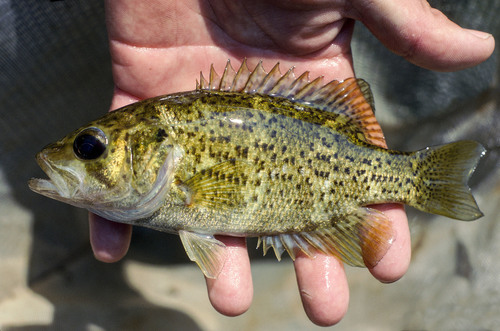
Ozark Bass
The Atlantic Bluefin Tuna (Thunnus thynnus) is a highly migratory species renowned for its size, speed, and commercial value. It's a top predator in the marine ecosystem, playing a critical role in maintaining balance. This species is also notable for its unique physiology, including a warm-blooded circulatory system.
3 7 years
Lifespan
15 - 25 cm
Length
Least Concern
Conservation Status
5 km/h
Swimming speed
Carnivorous, Insectivorous
Diet
Local Migration
Migration
Appearance Overview
The Atlantic Bluefin Tuna is renowned for its large size, metallic blue back, and yellow or silver sides, making it a striking presence in the ocean.
Color
Dark metallic blue on top with a silvery underside
Second Dorsal Fin
Reddish-brown
Finlets
Bright yellow, edged in black
Length
up to 13 feet (4 meters)
Weight
up to 2,000 lbs (907 kg)
Diet
Carnivorous, feeding on fish, squid, eels, and crustaceans.
Feeding Behavior
Hunts by sight, using its speed and agility to capture prey. It often coordinates with others to herd and trap schooling fish.
Social Behavior
Forms schools, sometimes segregated by size. Highly migratory, traveling long distances across oceans for feeding and breeding.
Commercial Relevance
Extremely high value, especially in sushi and sashimi markets, where a single fish can fetch hundreds of thousands of dollars.
Conservation measures
Subject to international fishing quotas, monitoring programs, and efforts to reduce illegal fishing. Marine protected areas also aid conservation.
Status
Endangered
Threats
Overfishing, bycatch in fishing gear, climate change affecting prey distribution, and habitat degradation.
Habitat Distribution
Depth Range
0-1,000 meters, though they often stay closer to the surface.
Geographic Range
North Atlantic Ocean, including the Mediterranean Sea. It is divided into western and eastern populations.
Preferred Environment
Primarily pelagic, preferring temperate and subtropical waters. They inhabit both coastal and open ocean environments.
Reproduction and Life Cycle
Breeding Habits
Spawns in warm waters; the western population spawns in the Gulf of Mexico, while the eastern population spawns in the Mediterranean Sea.
Development Stages
Eggs hatch into larvae, which quickly develop into juveniles. Growth is rapid, and they continue to grow throughout their lives.
Fecundity
Females can produce up to 30 million eggs per spawning season, releasing them in batches.
Maturity Age
Matures at around 4-8 years, though this can vary between populations.
Faqs about Ozark Bass
How long do Atlantic Bluefin Tuna live?
Atlantic Bluefin Tuna can live up to 40 years.
Where can Atlantic Bluefin Tuna be found?
They are found in the Atlantic Ocean, from Newfoundland to the Gulf of Mexico in the west, and from Norway to the Mediterranean Sea in the east.
How fast can Atlantic Bluefin Tuna swim?
They are among the fastest fish, capable of bursts of speed up to 43 mph (70 km/h).
Are Atlantic Bluefin Tuna warm-blooded?
Yes, they are warm-blooded, which helps them maintain high body temperatures, aiding in muscle efficiency during hunts in cold waters.
What are the predators of Atlantic Bluefin Tuna?
Atlantic Bluefin Tuna are apex predators, meaning they are at the top of their food chain and have few natural predators other than large sharks and orcas.
What is the biggest threat to Atlantic Bluefin Tuna?
The biggest threat is overfishing, primarily driven by high demand in sushi markets. This has drastically reduced their population.
Copyright @ Nature Style Limited. All Rights Reserved.
 English
English